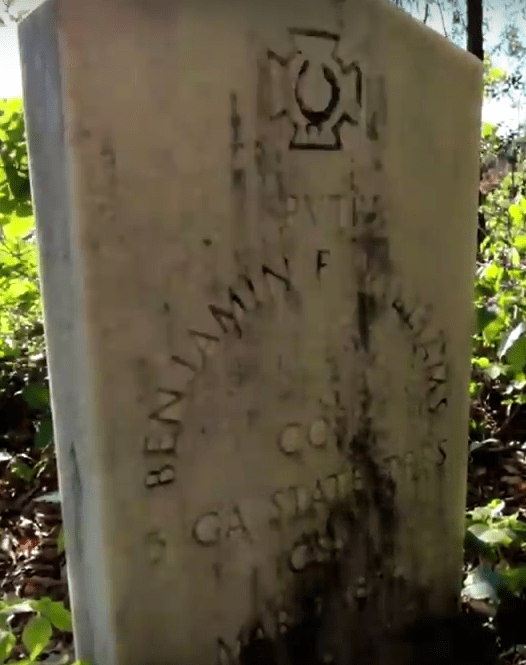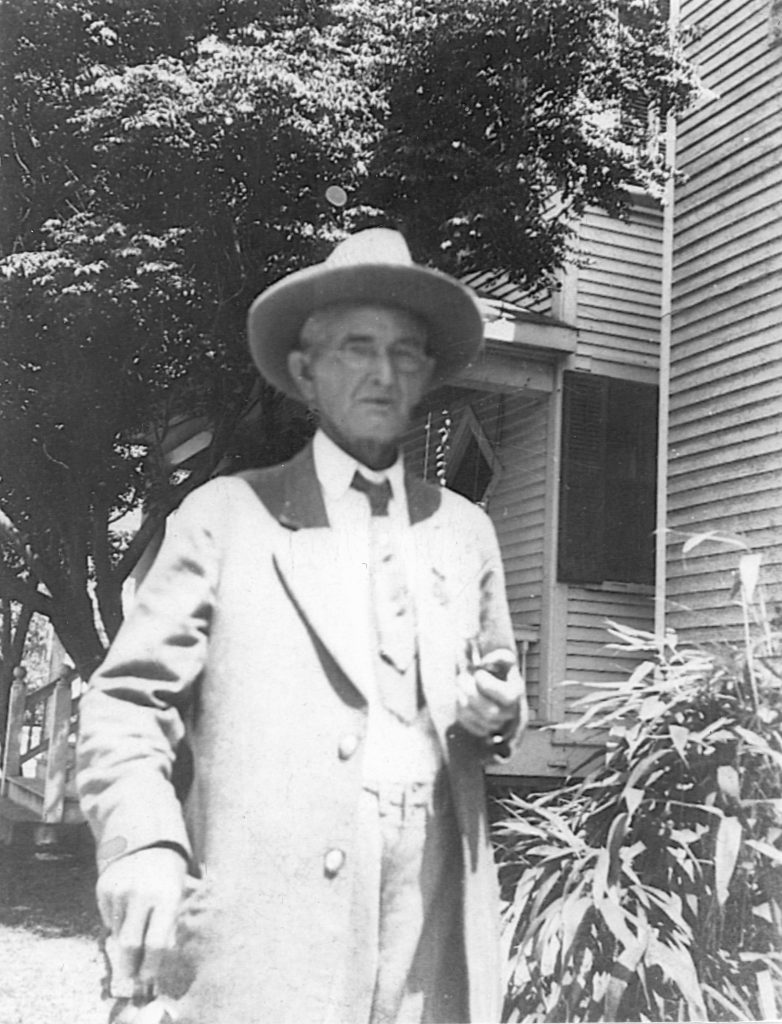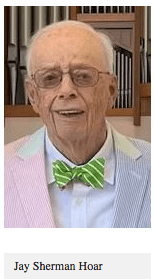From The South’s Last Boys in Gray
By Professor Jay S. Hoar Condensed from pp. 1248-1262
used with permission

[the new Confederate marker placed May 25, 1996]
[Image taken from an episode of Sidestep Adventures with Robert Wright used with permission]
Benjamin Franklin Williams
March 7, 1854 – August 26, 1943
{Explanatory Note: This story has proven slow in the composing. Of some 900 aged personalities, South and North, among our nation’s last surviving veterans of The War Between the States whom the writer has researched during 1971-1995, this CSA wagoner-patriot-youngster proved to be the second toughest (most challenging) of all to verify and authenticate – second only to Willie Johnston (August ?, 1850 – ? 189?), a drummer boy of the Third Vermont Infantry and early (& youngest ever) recipient of the Congressional Medal of Honor. Because the Williams Story has resurrected its own memorable odyssey-in-the-unraveling, the writer (hereafter I) would like to pass along precisely how its tarring truths suspensefully came to life. Hence, this present departure from an ordinary narrative mode.}
I believe that I first learned of Benjamin Franklin Williams’ identity when in 1972 I noticed on page 279 of Pennsylvania at Gettysburg (Vol. 4, Paul L. Roy, Cmplr) “C – WILIAMS, BENJAMIN FRANKLIN, 1800 WADE AVE., N.E. Atlanta.”
I didn’t think much about this name for quite some time, noting only that I had far fewer Ben Franklins among my 900 oldsters than I had George Washington Somebodies. The following is from a one-page featurette entitled “A Lingering Mystery Shrouds Benjamin Franklin Williams (185? – 194?) – An Active C.S.A. Patriot at Age Nine” . . . the death year pure guesswork. And it appeared in Confederate Veteran (March-April 1992) with this opening confession of failure.
After some nine years of fruitless research, the featurette is my ultimate effort on behalf of an apparently all-but-forgotten Confederate personality. My ambition remains the same: to discover Benjamin Franklin Williams’ date and place of birth that I might fittingly honor him among the last (and youngest) grand old Boys in Gray. The one encouraging piece of evidence I have learned in recent years is in an Atlanta Constitution story (10/14/41) on the 51st National Reunion of the U.C.V. (& 46th Reunion, S.C.V.) in Atlanta. Pictured among twenty aged veterans of the Gray is “B.F. Williams, 87, of Columbus, (Ga.), fingering a golden sword that was his father’s, a memento of the Mexican War; he recalls how, as just a little shaver, he drove supplies to Columbus to feed the troops there.” Of Georgia’s then 56 known Old Rebs, he was one of ten attending. This confirming evidence that he was indeed alive then was sent to me on April 10, 1991, by Charles Kelly Barrow, Georgia Division Historian, S.C.V., and Historian M.O.S.B., whom I wish to thank heartily.
Had it not been for an enterprising and prescient writer, Martha N. McLeod, who interviewed Cmdr. Williams, U.C.V., around 1938 for her forthcoming Brother Warriors (1940), we today would most likely be unaware of Williams’ humble role in the “War Between the Yankees and the Americans.” What Ms. McLeod learned in 1938 directly from him we are privileged to share from her collective biography (pp. 319-20) and from mine (The South’s Last Boys in Gray, pp. 46-47).
“At the age of nine I was engaged in the War. My older brothers and father carried gunpowder and shots. I was too young to enlist as a soldier and carry a gun, but I did duty at the Quartermaster Supply Department throughout the four years of the war.
My father served as an enrolling officer at the beginning of the war. He got up a company of young boys and drilled them. When the last call for volunteers came, Father went to the war. The company of young boys he had prepared, gave their services by hauling supplies to the camp depots. These provisions were gathered around the country from the farmers, who gave a certain portion of their foodstuff to the quartermaster at the camp commissary. I carried lots of supplies to Wheeler’s Cavalry.
One exciting come-off was when I ran a bunch of Yankees about two miles by myself. You bet, I was leading them – they tried to catch me, but I outrun ‘em. They shot once in a while, just to see how fast I could run, but if they met to hit me, I outrun the bullets.
You’ve heard us folks down here in Georgia referred to as “Georgia Crackers;” Well, that label dates back to the ox-cart days. A long time ago traveling was mighty slow. People drove oxen hitched to little covered wagons. In order to get to town to do a little trading, a fellow had to start out in the middle of the night. Now, oxen are slow animals and sometimes just like to stop and stand still in the middle of the road. The drivers carried rawhide whips which they twirled in the air and snapped with a loud crack. The noise drove the oxen on. Lots of times the crack of the whip awakened people living along the roads to town and they would remark, ‘There goes a cracker.”
This then exhausts my knowledge on Cmdr. Williams. His C.S.A. service was good enough for his fellow comrades, quite obviously, and it is good enough for me. . . that I want to honor him in a forthcoming national study, “Callow, Brave, and True,” where he surely is worthy of careful mention. It would appear he left no descendants. Possibly his attendant, Mrs. Langley (of Atlanta?) might have children yet who knew Cmdr. Williams? Whatever happened to him remains the haunting question. I will confer a signed hardcover on whoever is first to disclose further details on Cmdr. Williams, softbound copies upon the next two who can expand my knowledge of him and signed original tabulations from my latest unpublished study for any helpful contributor who can remove this stubborn enigma. . . .
{End of Published Query in Confederate Veteran magazine}
In response to the article a letter of April 2nd arrived from David L. Bridges (S.C.V. Camp 1347) of South Daytona, Florida, providing William’s hometown of Louvale, Georgia, and his parentage, family, and burial site. Hoar then fired off a letter to the nearest newspaper to Louvale, contacting its editor, Rena Cobb. This led to a letter from one of her readers, Joseph F. (Joe) Carter, dated May 17th, who turned out to be a great grand nephew of B.F. Williams. Hoar and Carter corresponded for a year as Carter reached out through the family and local connections to gather and send the details of Ben’s story along with photographs and a description of the cemetery:- This plot lies on property they owned off west of Louvale village and fronts along the west side of a dirt road, not far from B.F.W.’s birthplace – Louvale-Holloman Creek Church Road. The graves n. to s. are B.F.W. (no d.o.d.), Nathaniel (his father), Louisa A. Cleveland (his mother), and Ida (his sister). They face west. Flat rectangular slabs cover each.
Ben was known throughout the family as “Uncle Tobe.” He married and had five children. Carter explained in the early correspondence that there was no date of death that he could find anywhere, but he was determined to find it.
A letter of June 23rd from Thelma Anna Richardson (Mrs. Thomas Lee) Wilder, a great grand niece, added more details about Uncle Tobe:- Uncle Tobe lived near Link, “wide place in the road,” and would come in to Louvale on a sled 5’ long X 3’ wide drawn by a mule. With a solid wood floor and low center of gravity, it had a removable straight back chair mounted mid-way. He loved children. We knew him at a distance by his big brown felt hat. . . . Uncle Tobe lived some 70 years at or near his birthplace but in the early 1930’s he moved from his old home place to a small cabin he and his son Tigner had built in a hollow off the highway north of town 2.3 miles. They had a dug spring large enough to bathe in. We were baptized in it. Here tell Tigner may’ve had a still for his own private stock.
A lot of family history was shared by way of the two correspondents, but still no date of death.
On toward summer’s end, during the month of August, Professor Hoar received an inquiry from James Gaston, Jr. of Fair Oaks Plantation, Americus, Georgia, requesting copies of his Southern study for academies with which he was affiliated. Hoar was also invited to speak at Gaston’s Camp #78, S.C.V. in Americus. Plans were made for the speaking engagement to be followed by a trip to Louvale to meet with the families of Uncle Jobe. The trip took place in May of 1993.
A planned one-day visit to Louvale stretched beyond three nights, spent at the Wilder house, sleeping in an antique bed with an imposing headboard, which might well have been occupied in earlier times by Ben himself. He visited many local places, including the Williams’ burial ground, and met many of the family and neighbors, some of whom had been present at Uncle Tobe’s funeral. They could agree it took place in the summer of 1943, but no one could remember the exact day.
A clearer picture of what life was like for Ben during the war years emerged. He desperately wanted to be a part of his father’s military home guard organization attached to Georgia’s 780th Military District, which recruited boys age 9-13 with a few older men, but his parents refused. The boy persisted until they finally compromised to allow him to participate as mascot status. Presumably, he started training in mid-August of 1861, and was admitted into the unit in mid-September at the age of 7 years, 6 months, and 10 days. Officially his age was recorded as 9 years.
These boys served as mail carrier, forager, messenger, hostler, water boy, spy, lookout, produce gatherer, and wagoner. Knowing the terrain, roads, trails, waterholes, and natives made him ideal for becoming a commissary supplier in northern Stewart County and western Chattahoochee. After learning what farmers could supply what food stuffs and familiarizing himself with a penciled map which he later memorized, Ben acquired a mule and wagon cart and became a gatherer of farm produce as well as home comforts (soap, towels, clothing, etc.) and letters to the Confederate depot and outpost to an element of General Joe Wheeler’s forces near the Alabama line. In warmer weather, he ran his route every ten or twelve days; one day to gather his load, another to deliver it to the Quartermaster Depot, and a third to return home. In mid-June of 1862 Ben’s father relinquished his command to enlist in the infantry. For two years he stayed in the Columbus, Georgia, area and his son could visit on occasion and even spend the night. At war’s end, B.F.W. was one of he youngest war veteran at 11 years and 1 month.
On the last hour at Wilder’s, Hoar spoke by phone with editor Rena Cobb who shared that she was close to finding Williams’ obituary and would send it on to him as soon as she had it. In her June 4, 1993, letter she wrote: “Dear Professor Hoar: Thank you for your letter and enclosures of May 30. Luck and the Almighty were with me today. Here is B.F. William’s obituary. He died in Decatur, near Atlanta, in DeKalb County, Aug. 26, 1943.”
Hoar learned later that Williams had been living for about a year in the Decatur home of his daughter, Lucile.
Professor Hoar returned to Louvale in May of 1996. On the 25th of May, 1996, a long awaited memorial service was held for Benjamin Franklin Williams and his father, Nathaniel Jackson Williams. Complete with greetings, invocation, a few words from Professor Hoar, and the placing of flowers on the graves, each with its new informative granite Confederate marker, decked over with the Confederate flag, along with the placing of a wreath of magnolia leaves by Rena Cobb. The two flags were folded and presented. Cannons were fired in a Colorguard Salute followed by “Dixie” on guitar and a musket salute. Finally the service closed with a benediction and all returned to town for a gala community style Southern picnic.

Benjamin Franklin Williams
Photo from the Professor Hoar collection – Museum of the Bethel Historical Society

This article is dedicated in memorium to Professor Jay Sherman Hoar [1933-2023] who made it his life’s work to research and share the lives of the youngest to serve and the last to pass of the American Civil War. For more of Professor Hoar’s research, go to the sources section.
NOTE: Benjamin Franklin Williams is the second youngest by five days, born March 7, 1854, five days before Robert B. Tyler, born March 12, 1854, serving as 2nd Class Boy on the ship, USS Racer.
However, Robert didn’t start his service until age 9. Upon further research in Hoar’s Our Youngest Blue and Gray, his expanded chart of latest born lists eleven boys born even later than Robert, but only four whose service began at a younger age than B.F.W.’s. Willie H. Bush was 6 years, 5 months when he began service as valet to his father A. K. Bush at V.R.C. Elmira, New York. John Hance Osteen became a Mail Carrier Aid at Santa Fe River as a member of
Florida Home Guard at age 6 years, 7months. William Orlanda Newbold Lea began service as Cabin Boy on the Greyhound with the Georgia Mosquito Fleet at age 6 years, 5 months. Finally, at age 7 years, 2 months [approximately] Warren F. Dent became a Secret Service Letter Carrier in Maryland. Benjamin Franklin Williams was the only one of these youngest to serve the entire four years of the war.
